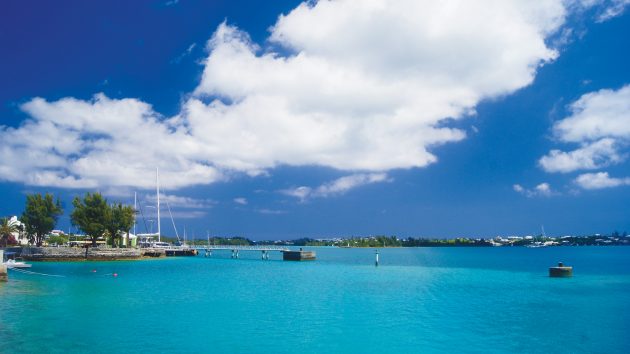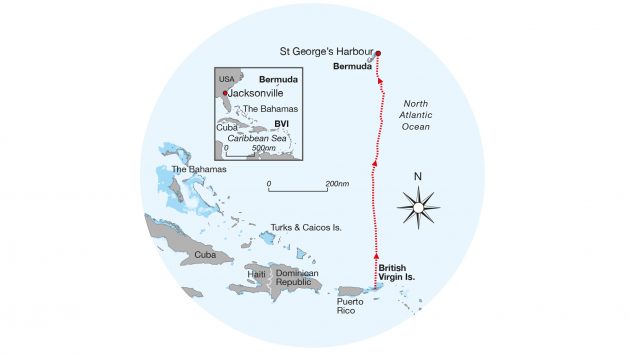Mike Reynolds and his wife Nicki were heading for Europe on their 34-foot Zen Again when a day of light squalls quickly turned into something much uglier
Our nadir was approaching. Our home port of Fremantle, Australia would be 6,880 miles away – straight down. From Bermuda our yacht Zen Again would need to literally fly to move further from home. And wherever we sailed from there we’d be heading towards home!
We were on our way in Zen Again to Europe to spend several years topping up the cruising kitty before resuming our circumnavigation. We had crossed the Southern Indian and the South Atlantic Oceans and had visited Cocos Keeling Islands, Rodrigues, Mauritius, Réunion, South Africa, St Helena and the eastern Caribbean.
Zen Again is a 1980s fibreglass 34-foot cruiser-racer. She underwent a major refit in Phuket while cruising south-east Asia. We equipped her for bluewater cruising, including SSB radio and Iridium GO! satellite messaging, but with neither wind sensors nor radar.
We had departed the British Virgin Islands six days previously, heading north with a 15 to 20-knot easterly breeze. We had enjoyed Champagne tradewind sailing conditions for two days, but the wind then veered through the south to the south-west, a heavy low overcast covered the sky and showers became persistent rain.
On day five, several squall lines had passed through with 30-plus knot winds and heavy rain. Several times we handed the main, sailing under part-furled yankee alone. Mostly we set two reefs in our cruising main which presented a trisail area and we furled the yankee to suit the conditions.

Post-refit Zen Again at the Cocos Keeling Islands
Throughout the passage we had been using our Aries windvane ‘Kaze’. It had struggled in the Indian Ocean due to the cross seas – southeasterly seas from the trades and southwesterly swells from the Southern Ocean – so we had used ‘Kami’ the autopilot. Kaze had handled the South Atlantic nicely and was doing a good job here too. We had rounded up once or twice during gusts as squalls went through, but Kaze had brought us back onto course rapidly.
The weather GRIB files showed the tail-end of another cold front coming our way. It had lashed Bermuda with 40-knot winds but the predictions showed less wind further south. They were wrong about that.
The morning had passed with squalls of up to 25 knots coming through with steady rain in and between them. The overcast sky made it impossible to see the squalls coming, but there seemed
to be a regularity to them. We were wrong about that!
At our 1400 change of watch we had double-reefed main and half-furled yankee set in 18 to 22 knots of wind. We were both below getting changed. Suddenly the wind noise rose to a howl and just kept going up to a screech.

After two days of easy cruising north away from the British Virgin Islands the sky clouded over and squalls began to blow through with increasing intensity
We felt the boat broaching. As we raced on deck the noise of the yankee flogging matched the wind noise. The shaking of the rig was horrific. The boat was on her ear with the lee rail under. I took the helm as Nicki loaded the headsail furler winch.
The rain was torrential and horizontal – impossible to look into. I hauled the helm up and to my amazement Zen Again responded. As she bore away she stood up and accelerated. As the wind came behind her she took off – much faster than the 15 knots we had logged racing down waves under spinnaker. The huge bow wave created sheets of white water port and starboard, extending way above the sheer line.
With Zen Again surfing both down waves and up their backs Nicki got to work furling the yankee. Meanwhile I was discovering interesting facts about high speed sailing. The turbulence off the full-length skeg required huge tiller input for the rudder to ‘bite’. The ‘deadband’ was a good 20 degrees each side.
With the yankee furled Zen Again was still surfing dramatically down the waves.

The front has passed and Zen Again has survived a series of 60-knot squalls
I handed over the helm to Nicki, unlocked the main halyard and went forward to haul down the mainsail. Back in the cockpit I finally thought to make a note of our boat speed. We were still doing 8 to 10 knots under bare poles. It felt slow after the preceding drama.
After a few minutes the wind started to ease and our speed fell below our 7.2-knot hull speed. I’d been starting to think about streaming our Jordan series drogue. With matters back under control we put Kaze in charge and settled back to take it all in. The rain was so intense it felt like hail on our backs. The rain seemed to be beating the waves flat.
The following day we arrived in St George’s Harbour. We discussed our experience with other yachts. One had been 20 miles south of us and recorded 50 knots. Another had been 20 miles north and recorded over 70 knots. So we reckon we had 60 knots of wind – significantly more than we had sailed in before. We said a big thank-you to Japanese builder Yamazaki Yachts and designer Ken Hayashi, and to Thai refitters Precision Shipwright Services.
We spent two weeks exploring Bermuda. It’s a fantastic place. Like in St Helena, people in Bermuda ‘get’ us yachties. We hope to revisit one day, but we won’t be mentioning it being our nadir again!
Lessons learned
- Visibility – Be extra cautious when sailing in low, overcast conditions – it hides what’s coming and you won’t be able to see squalls before they hit you.
- Squalls – Take care when exiting the tropics. The increasing difference between warmer and colder air can make squalls in fronts very nasty.
- Downwind sailing – Consider dropping the main entirely when sailing downwind in squally weather as it is much harder to drop the main once a squall hits.
- Sailplan – We could have used our storm-jib-sized staysail instead of the yankee. It would have been slower between squalls, but we wouldn’t have been on the edge of control in the stronger wind.
- Stay in control – Don’t hide below from the weather, even at watch changes. As Alfred Wainwright said, ‘There’s no such thing as bad weather, only unsuitable clothing.’ It’s crucial to get a feel for conditions on deck, and whether the boat is properly set up.
- Radar – We didn’t have radar at the time, but we do now. It helps identify squalls by showing us the rain, and advance warning makes a huge difference, especially at night.
- Proper wind information – We now have wind instruments and record all of our data using Signal K, but that’s another story.
Enjoyed reading this?
A subscription to Yachting Monthly magazine costs around 40% less than the cover price.
Print and digital editions are available through Magazines Direct – where you can also find the latest deals.
YM is packed with information to help you get the most from your time on the water.
-
-
- Take your seamanship to the next level with tips, advice and skills from our experts
- Impartial in-depth reviews of the latest yachts and equipment
- Cruising guides to help you reach those dream destinations
-
Follow us on Facebook, Twitter and Instagram.






